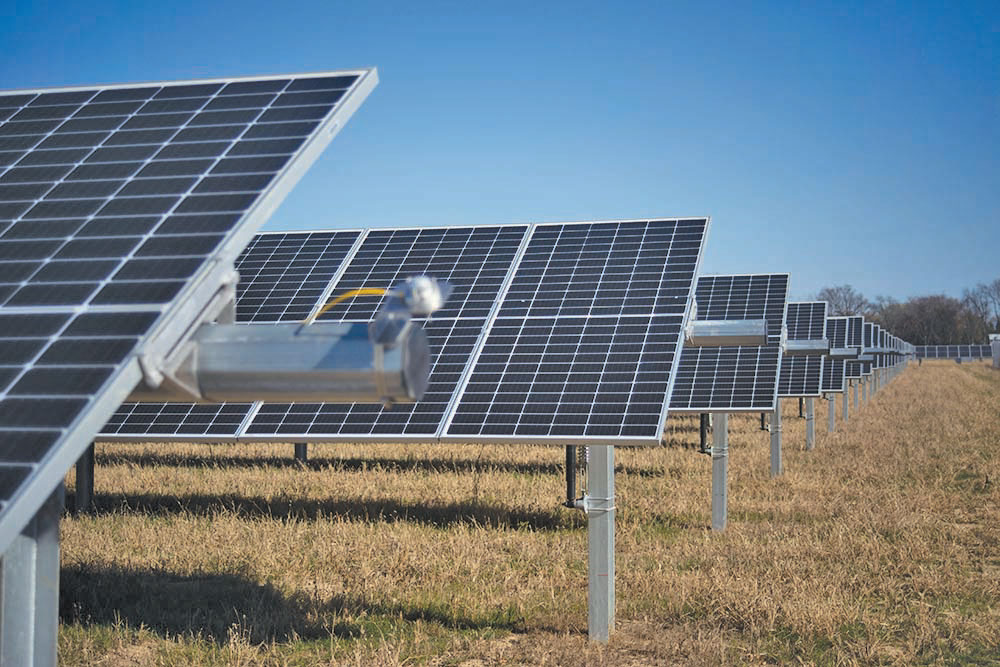2 meetings addressing short-term, long-term guidelines
Noting a growing interest in cultivating solar energy, including a proposal for a new solar park being considered this week, Wayne County officials also are working on new guidelines for future projects.
Proposal for new solar park
During an Oct. 13 public hearing offered by Wayne County Board of Zoning Appeals, Indiana Municipal Power Agency and applicant Chris Sanders will request a variance of use to operate a 27.73-acre solar park at 4752 Gates Road in Centerville.
The hearing is set for 6 p.m. Thursday in Wayne County Administration Building, 401 E. Main St., Richmond.
IMPA also will ask for a variance from development standards to allow an increase in the height of the park’s fence.
IMPA already owns the nearly 140 acres of land where the approximately 13,290 solar panels would be installed, said Niki Dick, IMPA’s senior director of marketing communications.
Dick said that while the address is in Centerville, the property is within Richmond’s electric service territory, and it is near an existing Richmond point of interconnection. Since it’s in Richmond’s fringe area, Wayne County officials will make the decision.
Pending all necessary approvals, construction could start on the park in an estimated 6 to 10 months, with the park coming online in 18-24 months, Dick said.
The park’s expected capacity would be 6.125 MW-AC.
Related solar park documents can be found through the county’s planning and zoning department in the administration building.
In addition to IMPA’s request, five other items are on the BZA agenda related to projects proposed by small business owners or homeowners.
Those projects are in the 17600 block of Frank Myers Road in Cambridge City, the 7400 block of Sugar Grove Road in Economy, the 11300 block of North Centerville Road in Williamsburg, and the 4500 block of North U.S. 35 in Richmond. A legal ad containing more details about each proposal was published in the Sept. 28 edition of Western Wayne News and can be found at westernwaynenews.com.
County ordinance
As part of their recent meetings, Wayne County Advisory Plan Commission members (Gary Saunders, Theresa Scruggs, Dan Phelps, Ken Paust, Steve Becker, Gordon Moore and Dan Hollenberg) have been discussing regulations for solar parks.
They have another special meeting planned for 6 p.m. Friday, Oct. 14, to discuss solar park regulations, and have a regular meeting on Oct. 20. Another meeting might take place Oct. 27 to finalize details before a public hearing that could be as soon as Nov. 17.
Plan commission is using Indiana’s default standards in Senate Enrolled Act 411 and Randolph County’s Solar Energy Systems Siting Regulations, a 43-page document, as their frames of reference.
Paust said he thought it would be efficient to evaluate Randolph County’s plan as a starting point and discuss potential revisions before local adoption.
Members have been discussing guidelines for solar parks, considering factors such as setbacks, buffer, height, ground maintenance, fencing, burying cables, glare and signals, sound, drainage and water ways, decommissioning and site restoration.
For instance, members reached consensus at their Sept. 29 meeting that panels must be at least 250 feet from the closest part of any home, with a goal of improving neighbor relationships. That’s a larger setback distance than what Randolph County requires.
They also want grass rather than stone under the panels to improve drainage, and to mandate county drainage board approval during the design and installation. Another preference is a 25-foot maximum height for panels when tilted.
Paust, who serves as president of Wayne County Commissioners and who also leads the county’s advisory plan commission, has set a goal for having a local ordinance in place before the end of the year.
He said it’s better to address concerns and establish expectations now while there’s adequate time, and then be prepared to work with anyone considering a solar park here, as federal subsidies make solar more attractive.
At this time, most area solar projects are less than 50 acres, but northern Indiana has been welcoming larger parks, he said.
Laura Miller, county planning and floodplain administrator, said businesses or homeowners wanting to mount a few solar panels on their building or grounds can seek permits for those additions like they would for other projects, instead of having to go through approval for a solar park.
State lawmakers last year tried to usurp local control regarding green efforts, Paust said, but he believes local boards of zoning appeals should have control over approving or denying those projects.
He’s found residents have mixed opinions about solar panels as they do with windmills, but he says the expansion of solar power is “inevitable.” He noted some existing solar parks in Wayne County, such as one in the Eagle Trace subdivision, that is largely hidden from neighbors through extensive landscaping.
Paust said property owners who want to place solar panels on their land should be able to do so, if local standards are followed. He cited the importance of property rights in allowing farmers to set their income, since some might be able to make more money with solar than they can through agriculture.

